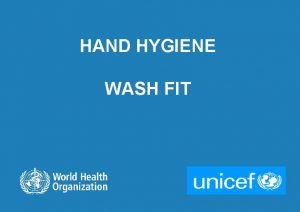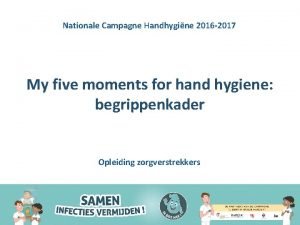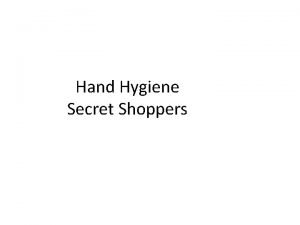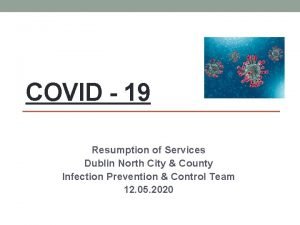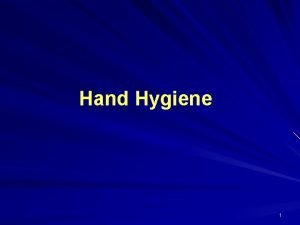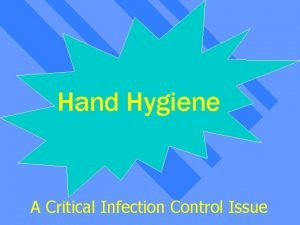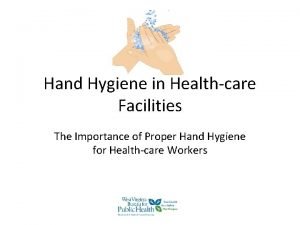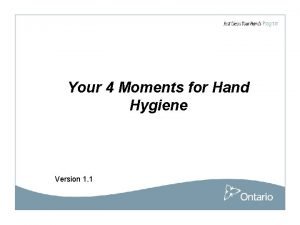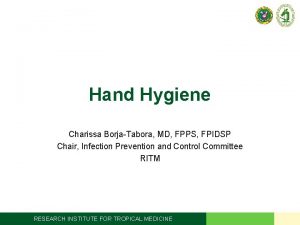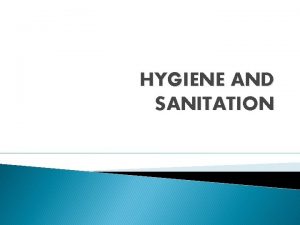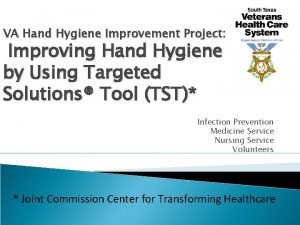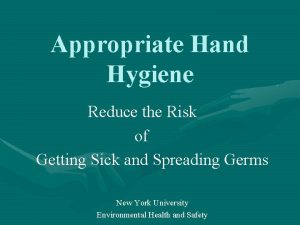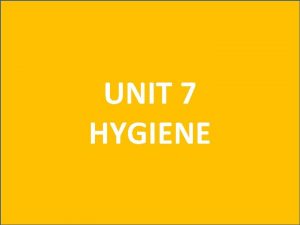1 HAND HYGIENE 2 v Appropriate hand hygiene










- Slides: 10

1 HAND HYGIENE 2 v Appropriate hand hygiene upon entering and exiting every patient room v v 4 LINE NECESSITY Can line be removed Does patient have a peripheral line 3 CUROS CAPS v v 5 DRESSING Use Curos caps on every port and every line Scrub the hub (needleless connector) prior to accessing SITE & LINE INSPECTION ADULT & PEDIATRIC CLABSI v v 6 v v Assess at least every shift: v Site and line inspection v Blood return Dressing clean, dry, intact & current Dressing change Q 7 days and PRN TUBING & NEEDLELESS CONNECTORS Change IV tubing and needleless connectors every 96 hours 7 v v CHG BATHING Daily CHG bathing Change bed linens and gowns daily 8 v BLOOD CULTURES Do not draw routine blood cultures from central lines

ADULT & PEDIATRIC CLABSI 1 2 INDICATIONS: Ø Examples include but not limited to: pharmacy link with full text 1. Vesicant or irritating medications 2. Total parental nutrition (TPN) 3. Peripheral parenteral nutrition (PPN) 4. Hemodialysis 5. Advanced hemodynamic monitoring 6. Lack of adequate peripheral access 7. Home infusion of medications 3 ALTERNATIVES: 1. Peripheral IV (PIV) 2. Midline IV Ø Note: If long-term line necessity is identified, transition to a PICC and continue CLABSI bundle. Policy #12004 INDICATIONS Assess Line Necessity Every Shift! ALTERNATIVES LOCATIONS: ØConsider patient condition and treatment needs: 1. Subclavian 2. Internal Jugular (IJ) 3. Femoral: • Frequently re-evaluate for alternative sites or line types 4. PICC: • Placement sites will vary based on age, but usually placed in arm LOCATIONS

ADULT & PEDIATRIC Curos Cap On Every Hub, And Every Line, Every Time! CLABSI 1 2 CVC & PIV LINES: 3 CUROS CAPS AND TIPS: 1. Place a Curos cap on every hub (needleless connector) and every access port for both central and peripheral lines. 1. 2. NEW 2. Place a Curos cap on all peripheral line hubs (needleless connectors) even if a patient doesn’t have a central line! CENTRAL & PERIPHERAL LINES Change Curos cap when accessing and with tubing changes. Curos caps are single use! Must discard upon removal and apply a new Curos cap. NEW 3. ADMINISTERING MEDICATIONS: 1. Once a Curos cap is removed, scrub the hub (needleless connector) with alcohol pads for 10 seconds prior to access and between each medication administration! Scrub the hub for 10 seconds in addition to Curos caps. CUROS CAPS AND TIPS ADMINISTERING MEDICATIONS WATCH VIDEO! “Scrub The Hub For 10 Seconds Prior to Access and Between Each Medication Administration” Access the video by scanning the barcode with a smartphone or by clicking on the direct video link below.

ADULT & PEDIATRIC CLABSI Dressing: Clean, Dry & Intact! 1 CLEAN DRESSING 1. 2. 3. Dressing change frequency: • Once per week, and • PRN for visibly soiled or compromised dressings Visibly soiled/compromised dressings: • Excess blood & bodily fluids • External contaminants • Skin breakdown Label requirements: initials & date dressing change was performed NEW 4. Avoid premature dressing changes: • Wait the full week unless the dressing is compromised! • Increased disruptions equals increased risk for infection! CLEAN 3 2 INTACT DRESSING DRY DRESSING 1. 2. 3. Fluids underneath occlusive dressing create: • A medium for bacterial growth, and • Increase the risk for infection During routine bathing: • Always secure and protect dressings If a Biopatch is more than 50% saturated with blood/fluids: • Perform a dressing change and replace the Biopatch. 1. 2. 3. Dressing application considerations: • Location & surface area • Skin texture & creases • Hair growth To improve adhesive contact use: • Skin prep wipes • Adhesive sprays To prevent loose dressings: • Monitor the edges • Secure external ports NEW 4. If dressing edges are peeled back into the clear window, a dressing change is required, otherwise dressing reinforcement is acceptable! DRY WATCH VIDEO! “Performing A Proper CVAD Dressing Change” Access the video by scanning the barcode with a smartphone or by clicking on the direct video link below. INTACT

ADULT & PEDIATRIC CLABSI Site & Line Inspection Every Shift! Trialysis Cath (Pigtail) 1 Assess Signs & Symptoms Every Shift: • Erythema & Swelling • Drainage & Leaking • Pain & Burning • Itching & Infiltration • Cellulitis • Catheter secure/patent Assess Line Migration: • Assess length (cm) of line outside the body with every dressing change SITE & LINE INSPECTION 2 3 Blood Return: • Perform blood return check at least every shift! If No Blood Return Is Noted: • Reposition and/or roll patient • Troubleshoot line (confirm line is unkinked & unlocked) • If clotted line is confirmed, call MD for an order of Cathflo (alteplase) Pediatrics: • Pressure alerts: be aware of pressure alert frequencies signaling a line occlusion CHECK BLOOD RETURN Adult Guidelines: • Flush 8 -10 ml NS prior to access and between each med administration • Flush 20 ml NS after blood draws & blood infusions Pediatric Guidelines: • Flush 5 -10 ml NS prior to access and between each med administration • Flush 10 ml NS after blood draws & blood infusions Flushing Technique: • Flush using push-pause technique • Detach syringe with positive pressure, clamp line and attach Curos cap FLUSHING GUIDELINES WATCH VIDEO! “Administering Cathflo” Access the video by scanning the barcode with a smartphone or by clicking on the direct video link below. 4 Dialysis Catheters (Permanent): • RNs must have demonstrated competency in order to flush any dialysis catheter lumens Trialysis Catheter/Pigtail (Temporary): • Treat pigtail as a central line! a) Check blood return and flush pigtail every shift! • RNs must have demonstrated competency to flush all other temporary dialysis catheter lumens Attention! Never Replace Dialysis White Caps with Green Curos Caps! DIALYSIS LINES

ADULT & PEDIATRIC CLABSI 1 2 3 IV TUBING CHANGE: TUBING INTERVALS: SECONDARY TUBING: Change IV tubing every 96 hours: • Maintenance • Intermittent • Piggyback Note: Tubing should be changed anytime the line has been compromised (i. e. the line came apart from the IV and is dangling at the bedside) IV TUBING CHANGE Every 24 hrs: • TPN, Lipids, Lorazepam Every 12 hrs: • Propofol, Mannitol Every 4 hrs: • Blood (or every 2 units whichever occurs first) Back Priming Method: • If the primary IV bag and the IV piggyback are compatible (even multiple IVPBs) use back priming method instead of multiple secondary tubing! IV Tubing & Needleless Connectors! 4 5 NEEDLELESS CONNECTORS: Needleless Connectors: • Change every 96 hours with IV tubing changes OR when blood residual remains Policy #11958 MEDICATION TIMING SECONDARY TUBING NEEDLELESS CONNECTORS WATCH VIDEO! “Back Priming Secondary IV Tubing” Access the video by scanning the barcode with a smartphone or by clicking on the direct video link below. BLOOD DRAWS: • Do not remove or change needleless connector after drawing blood from line • Flush well after blood draw and only change needleless connector if and when blood residual remains • Note: change needleless connectors when drawing blood cultures! BLOOD DRAWS

ADULT & PEDIATRIC CLABSI 1 DAILY USE & GUILDELINES: DAILY USE of CHG wipes for all patients with: • CVC’s/PICC’s/Dialysis lines/Accessed Mediports & ALL ICU patients 2 BATHING PROTOCOL: • May bathe patient prior to using CHG wipes. • Use CHG compatible bathing wipes (make sure to toss all used wipes in trash). GUIDELINES • Do NOT flush wipes or leave them behind in patient rooms. • Do NOT use wipes on patients with a rash or an allergy to CHG. DAILY CHG WIPES BATHING PROTOCOL CHG BATHING! 4 3 5 STRAGETIC USE OF WIPES: ANTIMICROBIAL ACTIVITY: • Bathe with CHG wipes in the order shown in the diagram (on back). • Use all 6 wipes: Always bathe body part associated with the CVC line first, then clean 6 inches of the line nearest the patient, then bathe opposite limb. • Apply clean linens and gowns after CHG is dry. • CHG has antimicrobial activity that lasts for 24 hours. • Massage wipes firmly into skin. • Do NOT wipe off CHG wetness/moisture, allow CHG to completely air dry. STRATEGIC USE OF WIPES ANTIMICROBIAL ACTIVITY WATCH VIDEO! “CHG BATHING” Access the video by scanning the barcode with a smartphone or by clicking on the direct video link below. CHG COMPATIBILITY: • Only use CHG compatible barrier products and lotions. • CHG wipes are alcohol free and contain moisturizers. CHG COMPATIBLE PRODUCTS

Use all 6 wipes: Always bathe body part associated with the CVC line first, then clean 6 inches of the line nearest the patient, then bathe opposite limb.

ADULT & PEDIATRIC CLABSI 1 3. 4. 3 2 AVOID CONTAMINATION: CONSEQUENCES OF CONTAMINATION: 1. 2. Blood Cultures! Increased length of hospital stay Misdiagnosis of hospital acquired infections Increased costs Unnecessary use of antibiotics 1. 2. Practice Aseptic Technique: • Use CRMC’s triple cleanse procedure • Always draw blood cultures prior to initiation of any antibiotics Lab Must Draw Cultures Whenever Possible: • Lab has a contamination rate of less than 1%! (nursing is at 6%!) PROCESSES: Step-By-Step Instructions On Back 1. 2. 3. CONSEQUENCES OF CONTAMINATION Peripheral Blood Cultures: • Draw peripheral blood cultures whenever possible Central Line Blood Cultures: • Do not draw from central lines (due to high rates of contamination) UNLESS the physician is ruling out specific line infection • Wait 15 minutes between blood cultures that are pulled through a central line Insufficient quantity of blood may give false results! AVOID CONTAMINATION WATCH VIDEO! Drawing a Central Line Blood Culture Access the videos by scanning the barcodes with a smartphone or by clicking on the direct video links below. BLOOD CULTURE PROCEDURE

ADULT & PEDIATRIC CLABSI WATCH VIDEO! “Drawing A Central Line Blood Culture” Access the videos by scanning the barcodes with a smartphone or by clicking on the direct video links below Peripheral Blood Cultures *Only perform if lab can’t draw blood cultures 1 • Perform hand hygiene and don gloves • Identify patient: Name and MRN should match the label on specimen 2 3 4 5 6 • Mark 10 ml line on culture bottle • Label culture bottle with patient label • Cleanse bottle tops with alcohol • Leave alcohol prep on bottle until ready to use • Locate venipuncture site prior to cleansing skin • Release tourniquet during skin prep • Disinfect the site with a bath wipe prior to cleaning with alcohol • Clean site with alcohol and allow to dry • Clean site with CHG and allow to dry 7 • Perform venipuncture • Apply pressure to stop bleeding 8 9 • Remove alcohol pad • Place adaptor cap on aerobic bottle • Press down to. penetrate septum • Transfer blood from patient to bottle • Double check to ensure specimen and patient match • Send specimen to lab Central Line Blood Cultures *Not recommended unless a physician is specifically ruling out a line infection 1 2 3 4 5 6 • Perform hand hygiene and don gloves • Identify patient: Name and MRN should match the label on specimen • Mark 10 ml line on culture bottle • Label culture bottle with patient label • Place sterile towel under line • Cleanse bottle tops with alcohol • Leave alcohol prep on bottle until ready to use • Clamp CVC and stop infusion if possible • Attach syringe to needleless adaptor • Draw waste (10 ml) • Distal lumen is preferred • Clamp central line and remove syringe and needleless connector • Scrub catheter for 15 seconds and allow to dry • Remove 10 ml of blood per bottle for sample 7 • Connect specimen syringe to blood culture transfer device • Allow blood to fill bottle • 8 • Apply needleless connector and flush central line with 20 ml of saline 9 • If drawing second specimen, repeat steps • Wait 15 minutes between samples

